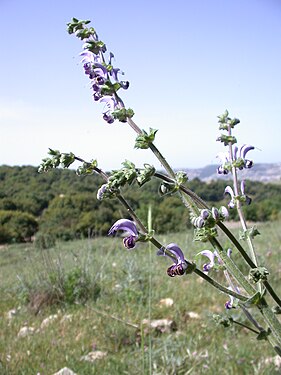Difference between revisions of "Salvia indica"
| Line 24: | Line 24: | ||
|min_zone=9 | |min_zone=9 | ||
|max_zone=11 | |max_zone=11 | ||
| − | |image= | + | |image=Salvia indica (scott.zona).jpg |
|image_width=240 | |image_width=240 | ||
}} | }} | ||
| − | + | '''''Salvia indica''''' is a species of [[herbaceous]] [[perennial]] plant belonging to the family [[Lamiaceae]]. It is native to a wide region of Western Asia that includes [[Palestine]], [[Iraq]], [[Iran]] and [[Turkey]]. It was first described by the [[taxonomist]] [[Carl Linnaeus]] in 1753.<ref name="IPNISindica1">{{IPNI|id=456431-1|date=29 January 2009}}</ref><ref name="IPNISindica2">{{IPNI|id=456432-1|date=29 January 2009}}</ref><ref name="IPNISindica3">{{IPNI|id=456433-1|date=29 January 2009}}</ref> It is unknown why he gave it the specific epithet ''indica'', since the plant is not from India. While ''Salvia indica'' is classified as a [[herbaceous]] [[perennial]], in cultivation individual plants often live no longer than two years.<ref name="Clebsch">{{cite book|last=Clebsch|first=Betsy|coauthors=Carol D. Barner|title=The New Book of Salvias|publisher=Timber Press|date=2003|page=149|isbn=9780881925609|url=http://books.google.com/books?id=NM0iwB8GrQYC&pg=PA149}}</ref> | |
| + | |||
| + | The native [[habitat]] of ''Salvia indica'' includes rocky limestone slopes between 350 to 5000 feet in elevation, where it flowers in April and May.<ref>http://www.idosi.org/wasj/wasj6%282%29/20.pdf</ref> The plant has an erect and stately [[Habit (biology)|habit]], forming a clump of rich grassy-green, ovate leaves with scalloped margins. The leaves are covered in long, soft, straight hairs. [[Inflorescence]]s are composed of specialized flowering stems growing from the plant's center, some two to four feet high. Widely spaced whorls of four to six flowers open slowly from the inflorescence. Individual flowers are two-lipped, with the one inch upper lip a shiny bright lilac color. The stubby lower lip has a trough with purple and brown spots on a white background. The flowers stay in bloom for quite a long time, nearly one month. The plant is typically propagated by seed, with seedlings often appearing near the plant.<ref name="Clebsch"/> | ||
| + | |||
| + | In the garden, the plant prefers full sun, loamy soil, and good drainage. After flowering the plants need very little moisture. It can survive temperatures down to 20 F. for brief periods.<ref name="Clebsch"/> | ||
==Cultivation== | ==Cultivation== | ||
| Line 44: | Line 48: | ||
<gallery perrow=5> | <gallery perrow=5> | ||
| + | File:Salvia indica 1.JPG | ||
Image:Upload.png| photo 1 | Image:Upload.png| photo 1 | ||
Image:Upload.png| photo 2 | Image:Upload.png| photo 2 | ||
Latest revision as of 19:58, 10 May 2010
| Habit | herbaceous
| |
|---|---|---|
| Height: | ⇕ | 24 in"in" can not be assigned to a declared number type with value 24. to 40 in"in" can not be assigned to a declared number type with value 40. |
| Width: | ⇔ | 24 in"in" can not be assigned to a declared number type with value 24. |
| Lifespan: | ⌛ | perennial |
| Bloom: | ❀ | early spring, mid spring, late spring |
| Exposure: | ☼ | sun |
|---|---|---|
| Features: | ✓ | flowers |
| USDA Zones: | 9 to 11 | |
| Flower features: | ❀ | blue, purple |
|
Salvia > |
indica > |
Salvia indica is a species of herbaceous perennial plant belonging to the family Lamiaceae. It is native to a wide region of Western Asia that includes Palestine, Iraq, Iran and Turkey. It was first described by the taxonomist Carl Linnaeus in 1753.[1][2][3] It is unknown why he gave it the specific epithet indica, since the plant is not from India. While Salvia indica is classified as a herbaceous perennial, in cultivation individual plants often live no longer than two years.[4]
The native habitat of Salvia indica includes rocky limestone slopes between 350 to 5000 feet in elevation, where it flowers in April and May.[5] The plant has an erect and stately habit, forming a clump of rich grassy-green, ovate leaves with scalloped margins. The leaves are covered in long, soft, straight hairs. Inflorescences are composed of specialized flowering stems growing from the plant's center, some two to four feet high. Widely spaced whorls of four to six flowers open slowly from the inflorescence. Individual flowers are two-lipped, with the one inch upper lip a shiny bright lilac color. The stubby lower lip has a trough with purple and brown spots on a white background. The flowers stay in bloom for quite a long time, nearly one month. The plant is typically propagated by seed, with seedlings often appearing near the plant.[4]
In the garden, the plant prefers full sun, loamy soil, and good drainage. After flowering the plants need very little moisture. It can survive temperatures down to 20 F. for brief periods.[4]
Cultivation
Propagation
Pests and diseases
Varieties
Gallery
References
- ↑ Template:IPNI
- ↑ Template:IPNI
- ↑ Template:IPNI
- ↑ 4.0 4.1 4.2 Clebsch, Betsy; Carol D. Barner (2003). The New Book of Salvias. Timber Press. p. 149. ISBN 9780881925609. http://books.google.com/books?id=NM0iwB8GrQYC&pg=PA149.
- ↑ http://www.idosi.org/wasj/wasj6%282%29/20.pdf
External links
- w:Salvia indica. Some of the material on this page may be from Wikipedia, under the Creative Commons license.
- Salvia indica QR Code (Size 50, 100, 200, 500)

